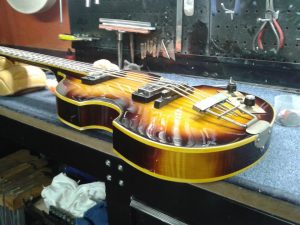To finish your guitar, or not to
The word re-finish has two meanings in the romantic sense of the word. You have the re-finish. This part is rebirth, making new, giving new life to something old. The re-finish part means done, to part with the old. This takes the scars and nicks and dents away that we have imparted so diligently in our journey together as master and instrument.
If a client has an old guitar and asks you to refinish his guitar, what do you say? This question has come up a lot. The problem is value versus appearance.

Considerations
It is not an easy answer. There are many things to consider. Look at condition then age, colour, finish, year, make and value, these are some of the considerations. Many times someone already started to sand or chemically take the old finish off. If that’s the case I would consider a refinish.
Finish changes colour with exposure to the UV in the sun. This can be difficult to control. Modern finishes are much more protected against UV rays.
How light impacts on colour
Blue becomes green, red becomes orange. To predict how the colour will change is extremely difficult. When the paint dries, it will also turn a few shades darker. You can finish an old Guitar in amber, just like it would look now after 40 years. Only to see it again in a few years looking terrible.
1k finish is usually a resin that dries with evaporation. 2k finish has a resin and a catalyst that forms a chemical reaction that hardens in 24 hours. UV curable finish has a resin and chemical hardener that reacts with the suns rays. It’s normally light in the spectrum from 490 to about 640. These are the basis of most finishes.
The process
To start off, first you have to remove the old finish. It can be done in two ways. The first is chemical and the other is sanding from coarse to fine until all the old Lacquer is gone.
Chemical stripper is often used and the ammonia inside the stripper dries the wood out. This will change the cells and can cause cracks later. Sanding has its own drawbacks. If you sand the old finish of, you will remove some wood as well. This will change the stiffness of the top.
If the top has a fine grain, this is called season rings or year rings. The distance between winter and summer growth will be very close to each other. The wider apart they are the less stiff the top will be. The thickness also affects the stiffness and this can change the sound that drew you to the guitar in the first place.
When you re-finish a guitar, it changes many attributes
It is important to take all of this into consideration. To start the finishing of the guitar, you will have to lay down a good foundation. We call this the base coat; this can be a sealer coat, made up of thinned finish. The second stage will be a colour coat which should be even and thin. After that you will seal the colour coat with one or more clear coats.
Sanding the surface with soft wet and dry sandpaper from 320 up to 1500, and then buffing the finish to a full gloss. It is hard to get all the steps right, but with practice it can be very satisfying.

See you next time… but feel free to learn more about us till then http://www.facebook.com/guitarsnz
Or get in touch to see how we can help you https://guitarrepairs.co.nz/contact/
Continue reading “To finish or not to finish your guitar, that’s the question?”
